
Park protects Gulf islands, seashore, forts
GULF BREEZE, Fla. – The Gulf Islands National Seashore, once an area used as protection from foreign invasion off the coast of Florida, is now protected itself.
It became part of the National Park Service in 1976.
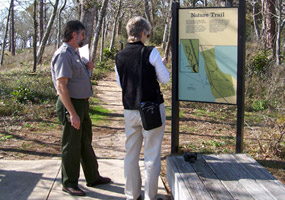 |
A visitor talks with a park ranger at Naval Live Oaks in the Gulf Islands National Seashore (Photo by Khris Parker). |
The Gulf Islands National Seashore consists of about 10 different units— Okaloosa, Santa Rosa, Naval Live Oaks, Fort Pickens, Fort Barancas and Perdido Key, Davis Bayou, Cat Island, West Ship, East Ship, Corn Island, and Petty Boy— that are dispersed along the Florida Panhandle and Mississippi Gulf Coast.
When Florida became a part of the United States in 1821, a Navy yard was established in Pensacola to protect the coast line. To protect the Navy yard, forts were established in three spots; Fort Pickens, Fort McCray on Perdito Key and Fort Barrancas.
| The Davis Bayou Walkway in the Gulf Islands National Seashore (Photo by Khris Parker). | 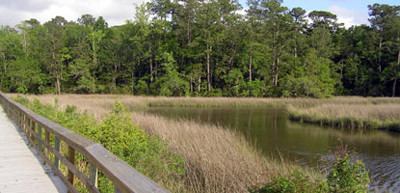 |
The forts became obsolete after the Civil War because they were no match for the weapons being built during the industrial age. Now the forts are historic structures that are opened to the public at no cost— with the exception of Fort Barrancas, which has an $8 admission fee.
Naval Live Oaks, the headquarters of the collection of preserved areas and located in Gulf Breeze, was set aside by President John Quincy Adams as a tree farm for naval trees.
Recent hurricanes have caused devastation to the sea shore area. Hurricanes Ivan and Dennis, washed out the road to Fort Pickens, so the only entrance is by walking, biking, or by boat. That was not the only damage the hurricanes did.
| Visitors walk along the beach road at Perdido Key in the Gulf Islands National Seashore (Photo by Khris Parker). | 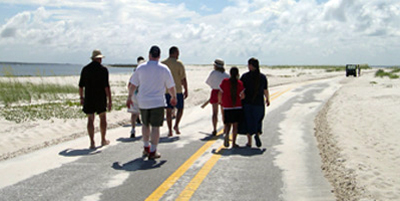 |
Park Interpreter Stanley Lawhead describes the damage that was incurred by the recent hurricanes.
“Actually, before Hurricane Ivan, you could not see that water. This was all overgrown with vegetation. With the storm serge that over washed the island out here, we’ve lost thousands of trees,” Lawhead said.
The hurricanes not only destroyed the natural landscape, but the amount of visitors as well. Before the hurricane damage, Gulf Islands National Seashore received about 4.5 million visitors a year. After the hurricanes, that number reduced to less one million.
Part of the reason for the steep decline is that most of the programs and facilities are integrated into the natural scenery, such as camp sites and roads, and were destroyed or severely damaged by the hurricanes.
Programs that are currently offered include ranger guided tours at Fort Barrancas, Junior Ranger Day Camps at Naval Live Oaks, candlelight tours at Fort Barrancas, and full moon walks at Fort Pickens.
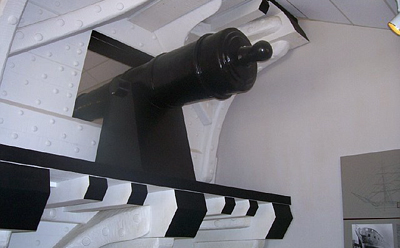 |
A cannon on display at the Visitor Center of the Gulf Islands National Seashore (Photo by Khris Parker). |
Despite the devastation the hurricanes have caused to the landscape, it has not detracted some visitors. Park-goers such as Nicole McGowan still visit Naval Live Oaks frequently.
“The hurricanes did a number on the parks here, but you still can’t beat the peace and tranquility you feel when you come out here, “McGowan said. “The view of the water is still breathtaking.”
Pensacola resident and first-time visitor Justin Parchman commented on how Naval Live Oaks currently looks.
“I’m not sure what this area looked like before the hurricanes hit, but even when walking over the dead tree branches on the nature trail, there’s still a lot to see,” Parchman said.
| A gun placement at Fort Pickens in the Gulf Islands National Seashore (Photo by Khris Parker). | 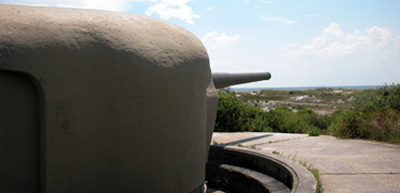 |
Because of the limited amount of visitors, the sea shore has also had problems with funding. Some of the attractions such as Fort Pickens that used to charge a small entrance fee can no longer charge it, because the road used to get there has been destroyed.
“It’s been a rebuilding process for a couple of years now,” Lawhead said. “After Ivan, those roads were rebuilt. Then Dennis and tropical storm Marlene came in and washed them out. Now it’s like $26 million to rebuild the roads.”
There are discussions between the Florida Department of Transportation and the National Park Service about the rebuilding of the roads. The Florida highway system wants to build the roads so they cannot be destroyed again. However, the National Park Service feels that roads with such structure will ruin the natural process of the barrier islands.
The park is currently doing an environmental assessment right now to figure out the best way to rebuild those roads. They are hopeful that the roads will be rebuilt in 2008.
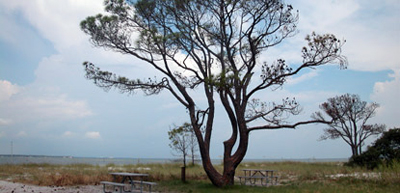 |
The Okaloosa area in the Gulf Islands National Seashore (Photo by Khris Parker). |
If You Go
- Naval Live Oaks 8 a.m. to sunset, Naval Live Oaks Visitor Center 8:30 a.m. to 4:30 p.m.
- Fort Pickens open for self guided tours 8 a.m. to sunset.
- Fort Barrancas Visitor Center (seasonal hours): March through October 9:30 a.m. to 4:45 p.m. and November through February 8:30 a.m. to 3:45 p.m. Tours given daily at 2 p.m.
- Okaloosa Area (day use only) 7 a.m. to sunset.
- Santa Rosa Area (day use only) 8 a.m. to sunset.
- Perdido Key Area (day use only) 8 a.m. to sunset.
| The nature trail is well marked so visitors know the names of trees and other plants in the Naval Live Oaks area of Gulf Islands National Seashore (Photo by Khris Parker). | 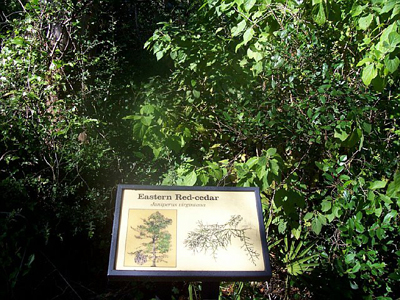 |
Directions:
- Florida Area: The Perdido Key Area is located off Florida Route 292, southwest from Pensacola; turn east on Johnson Beach Road.
- Naval Live Oaks Area is on U.S. 98 east of Gulf Breeze, Fla.
- The Okaloosa Day Use Area is on U.S. 98 east of Fort Walton Beach, Fla.
- To reach Fort Barranchas on board Pensacola Naval Air Station in Florida, use the Blue Angel Parkway (Florida Route 173).
- The Fort Pickens Area is west of Pensacola Beach on Santa Rosa Island. The damaged Fort Pickens Road is closed to vehicles but visitors may currently use it for biking or hiking.
- The Santa Rosa Area is located east of Pensacola Beach. The J. Earle Bowden Way (State Road 399) is closed to vehicles but visitors may walk or boat into the area.
- Mississippi Area: The Davis Bayou Area is on U.S. 90, east of downtown Ocean Springs, Miss. Use Exit 50 or 57 south from I-10.
- For more information call park headquarters for Florida at 850-934-2600 or call the Mississippi District at 228-875-9057.
- Visit the Web site at http://www.nps.gov/guis/.
| A broken tree remains along the beach at Naval Live Oaks in the Gulf Islands National Seashore (Photo by Khris Parker). | 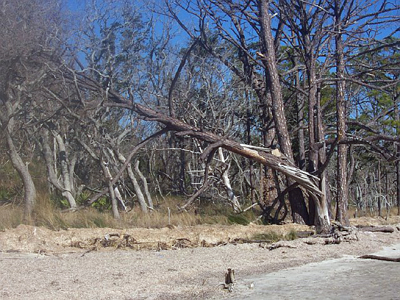 |

Comments are Closed